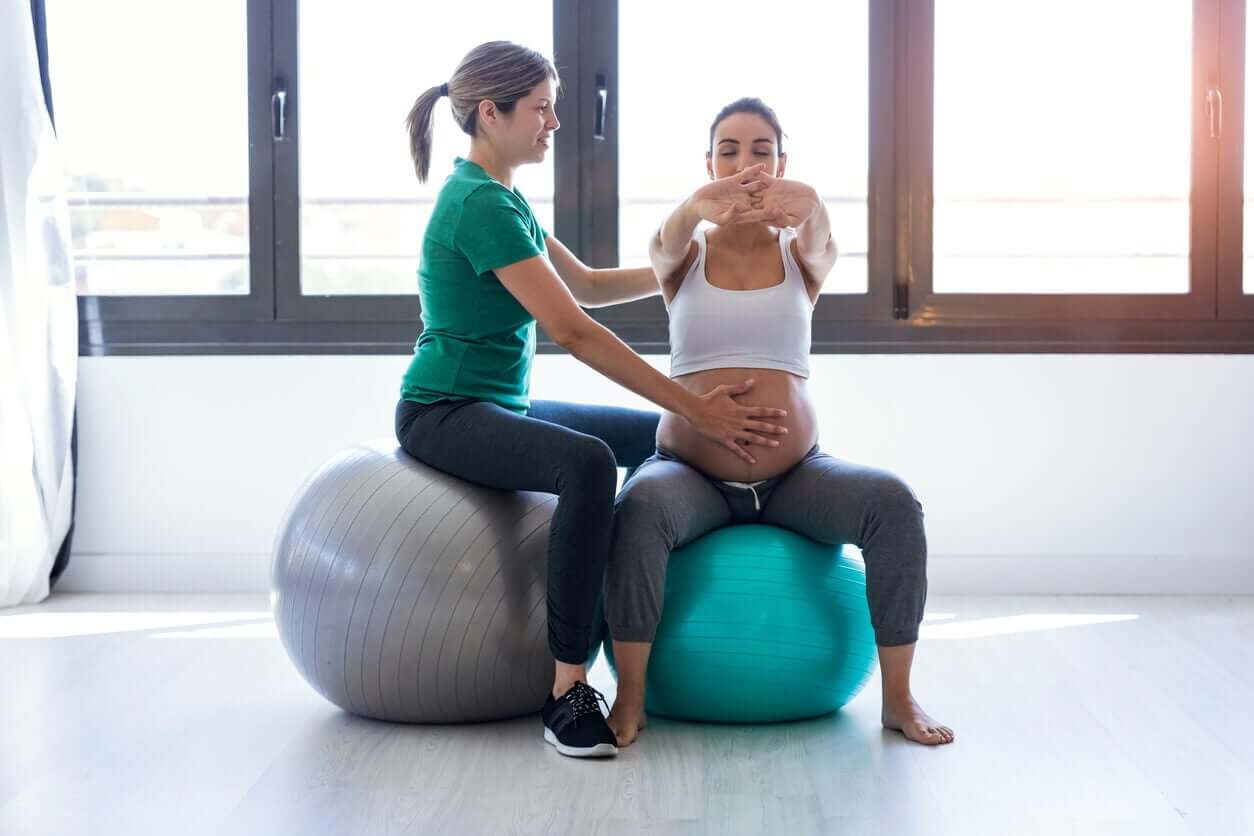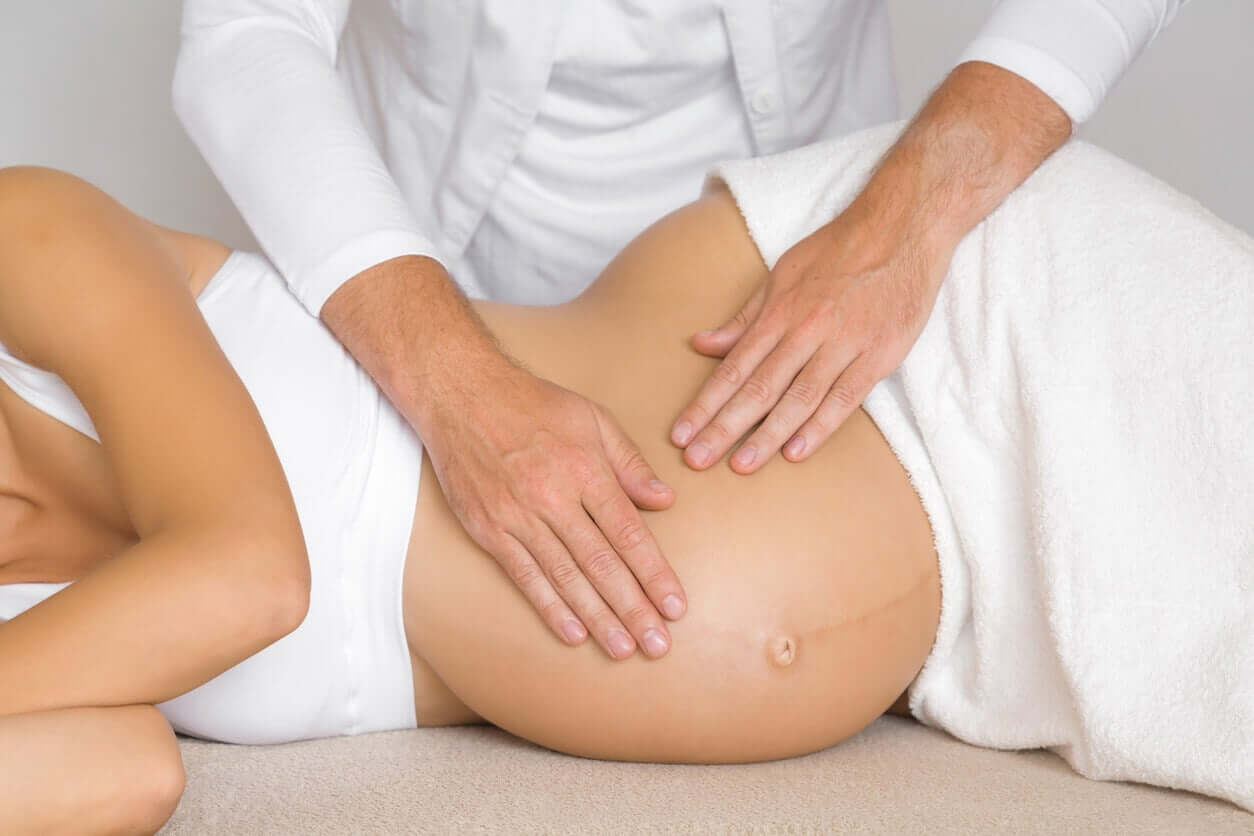6 Benefits of Perineal Physical Therapy in Pregnancy

Have you heard of perineal physical therapy during pregnancy? If you haven’t already, it’s time you found out what it’s all about.
Pelvic floor physical therapists are the professionals who are responsible for preventing certain postpartum conditions, such as prolapse or incontinence. In addition, they participate in the treatments of these conditions after birth.
Therefore, this type of therapy improves the quality of life of pregnant women from the first months of pregnancy to several months after delivery.
What is the pelvic floor?
The structures that contain the organs of the pelvis are called the pelvic floor (or perineum). It consists of muscles, ligaments, and other soft parts, which are supported by the coxal bones (or hip) and the sacrum coccyx.
The perineum does a lot of work during pregnancy so that delivery can take place without complications. And to avoid the latter, it’s important to maintain the correct alignment and functionality of the area in question. Perineal physical therapy is a great strategy to achieve this goal.
What is perineal physical therapy for in pregnancy?

Perineal physical therapy serves as a treatment for different urological and gynecological dysfunctions. During pregnancy, it also offers many benefits, both in the prevention and in the resolution of localized problems in this area of the body.
1. Improves the condition of the pelvic floor
After a personalized evaluation, the physical therapist can evaluate the health of the pregnant woman’s pelvic floor. Then, according to their findings, they determine if they need to carry out preventive work or provide treatment for any specific dysfunction.
2. Prevents complications during childbirth
There’s scientific evidence in favor of perineal physical therapy as a strategy to reduce the incidence of tears and episiotomies during childbirth.
3. Increases the knowledge of one’s own body
Through exercises of proprioception, mobility, and flexibility, the physical therapist teaches the woman to recognize her own body. In addition, it educates her posture and provides breathing techniques that improve her body awareness.
4. Optimize the quality of life during pregnancy
By improving the static and dynamic posture of women, it also favors their way of walking on a day-to-day basis. Therefore, it solves the discomforts of pregnancy, such as back pain.
5. Reduces pelvic floor disorders after birth
Regardless of the delivery route, after the baby’s born, different dysfunctions may appear in the perineum. These include prolapses, urinary or fecal incontinence, sexual dysfunction, pain in the coccyx, among others.
Prenatal physical therapy can prevent many of these situations, which undoubtedly generate enormous discomfort in women.
6. Offers important tools for pain management
Instruction on breathing techniques, postures, and active exercises provide the expectant mother with a tool to manage pregnancy, childbirth, and postpartum pain.
You may be interested in: Preparing for Childbirth: Everything You Need to Know
When is perineal physical therapy important?
All pregnant women should undergo at least one perineal physical therapy consultation, starting in the second trimester. This is recommended because the increase in uterine size causes a strain on the lumbar muscles and shifts the center of gravity forward.
In addition, the increase in the weight of the baby, added to the weight of the placenta and all the other physical logical changes of pregnancy, directly affect the condition of the pelvic floor.
Therefore, perineal physical therapy should be prescribed as a preventive measure for pelvic disorders, as well as for their treatment.
It’s common for women to come to the specialist a few days or weeks after birth, after having suffered tears or complications from an episiotomy. However, it’s better to promote preventive actions over curative ones.

About perineal physical therapy and its benefits
Perineal physical therapy has become more visible in recent years. At present, this discipline integrates the multidisciplinary teams that treat the pelvis in any sex and age group.
The physical therapist’s approach varies from patient to patient, and a wide variety of techniques are available: Manual, hypopressive exercises, body awareness, strengthening exercises, and pelvic mobility.
For pregnant women, the application of perineal massage is a simple strategy to improve pelvic flexibility. Likewise, it provides all the necessary information about this area of the body so that the mother learns to recognize its anatomy before delivery.
These massages can be done at home and can be self-administered or done by someone you trust. Before starting with them, it’s important to have the correct evaluation of your doctor or physical therapist.
In summary, perineal physical therapy improves the quality of life of people who suffer from conditions of the pelvic area and is an effective strategy for improving the health conditions of the pregnant woman prior to birth.
Have you heard of perineal physical therapy during pregnancy? If you haven’t already, it’s time you found out what it’s all about.
Pelvic floor physical therapists are the professionals who are responsible for preventing certain postpartum conditions, such as prolapse or incontinence. In addition, they participate in the treatments of these conditions after birth.
Therefore, this type of therapy improves the quality of life of pregnant women from the first months of pregnancy to several months after delivery.
What is the pelvic floor?
The structures that contain the organs of the pelvis are called the pelvic floor (or perineum). It consists of muscles, ligaments, and other soft parts, which are supported by the coxal bones (or hip) and the sacrum coccyx.
The perineum does a lot of work during pregnancy so that delivery can take place without complications. And to avoid the latter, it’s important to maintain the correct alignment and functionality of the area in question. Perineal physical therapy is a great strategy to achieve this goal.
What is perineal physical therapy for in pregnancy?

Perineal physical therapy serves as a treatment for different urological and gynecological dysfunctions. During pregnancy, it also offers many benefits, both in the prevention and in the resolution of localized problems in this area of the body.
1. Improves the condition of the pelvic floor
After a personalized evaluation, the physical therapist can evaluate the health of the pregnant woman’s pelvic floor. Then, according to their findings, they determine if they need to carry out preventive work or provide treatment for any specific dysfunction.
2. Prevents complications during childbirth
There’s scientific evidence in favor of perineal physical therapy as a strategy to reduce the incidence of tears and episiotomies during childbirth.
3. Increases the knowledge of one’s own body
Through exercises of proprioception, mobility, and flexibility, the physical therapist teaches the woman to recognize her own body. In addition, it educates her posture and provides breathing techniques that improve her body awareness.
4. Optimize the quality of life during pregnancy
By improving the static and dynamic posture of women, it also favors their way of walking on a day-to-day basis. Therefore, it solves the discomforts of pregnancy, such as back pain.
5. Reduces pelvic floor disorders after birth
Regardless of the delivery route, after the baby’s born, different dysfunctions may appear in the perineum. These include prolapses, urinary or fecal incontinence, sexual dysfunction, pain in the coccyx, among others.
Prenatal physical therapy can prevent many of these situations, which undoubtedly generate enormous discomfort in women.
6. Offers important tools for pain management
Instruction on breathing techniques, postures, and active exercises provide the expectant mother with a tool to manage pregnancy, childbirth, and postpartum pain.
You may be interested in: Preparing for Childbirth: Everything You Need to Know
When is perineal physical therapy important?
All pregnant women should undergo at least one perineal physical therapy consultation, starting in the second trimester. This is recommended because the increase in uterine size causes a strain on the lumbar muscles and shifts the center of gravity forward.
In addition, the increase in the weight of the baby, added to the weight of the placenta and all the other physical logical changes of pregnancy, directly affect the condition of the pelvic floor.
Therefore, perineal physical therapy should be prescribed as a preventive measure for pelvic disorders, as well as for their treatment.
It’s common for women to come to the specialist a few days or weeks after birth, after having suffered tears or complications from an episiotomy. However, it’s better to promote preventive actions over curative ones.

About perineal physical therapy and its benefits
Perineal physical therapy has become more visible in recent years. At present, this discipline integrates the multidisciplinary teams that treat the pelvis in any sex and age group.
The physical therapist’s approach varies from patient to patient, and a wide variety of techniques are available: Manual, hypopressive exercises, body awareness, strengthening exercises, and pelvic mobility.
For pregnant women, the application of perineal massage is a simple strategy to improve pelvic flexibility. Likewise, it provides all the necessary information about this area of the body so that the mother learns to recognize its anatomy before delivery.
These massages can be done at home and can be self-administered or done by someone you trust. Before starting with them, it’s important to have the correct evaluation of your doctor or physical therapist.
In summary, perineal physical therapy improves the quality of life of people who suffer from conditions of the pelvic area and is an effective strategy for improving the health conditions of the pregnant woman prior to birth.
All cited sources were thoroughly reviewed by our team to ensure their quality, reliability, currency, and validity. The bibliography of this article was considered reliable and of academic or scientific accuracy.
- Díaz, Yaima Almanza, et al. “Tratamiento rehabilitador de disfunción de suelo pélvico en paciente adolescente post lesión traumática de pelvis y región perineal.” Revista Cubana de Medicina Física y Rehabilitación 7.2 (2017).
- Sales, Joseane Peixoto Martins Meira, and Aline de Oliveira Netto. TÉCNICAS DE ALONGAMENTO PERINEAL DURANTE A GESTAÇÃO VISANDO A REDUÇÃO NAS TAXAS DE EPISIOTOMIA. Revista InterSaúde 1.2 (2020): 37-47.
- do Vale, Marina Baia, et al. Fisioterapia no controle das emoções durante o pré-natal: Um ensaio clínico randomizado. Research, Society and Development 10.9 (2021): e23810917918-e23810917918.
- Salazar Criollo, Verónica Carolina. Investigación bibliográfica sobre la eficiencia del fortalecimiento de la musculatura de suelo pélvico por medio de ejercicios de kegel y masaje perineal durante el tercer trimestre de gestación en la prevención de desgarro perineal durante el parto, de grado no especificado. BS thesis. Quito: UCE, 2021.
- Landa Quintana, Maitane. Masaje perineal para evitar o reducir el corte de la episiotomía. Revisión bibliográfica, 2018.
This text is provided for informational purposes only and does not replace consultation with a professional. If in doubt, consult your specialist.








